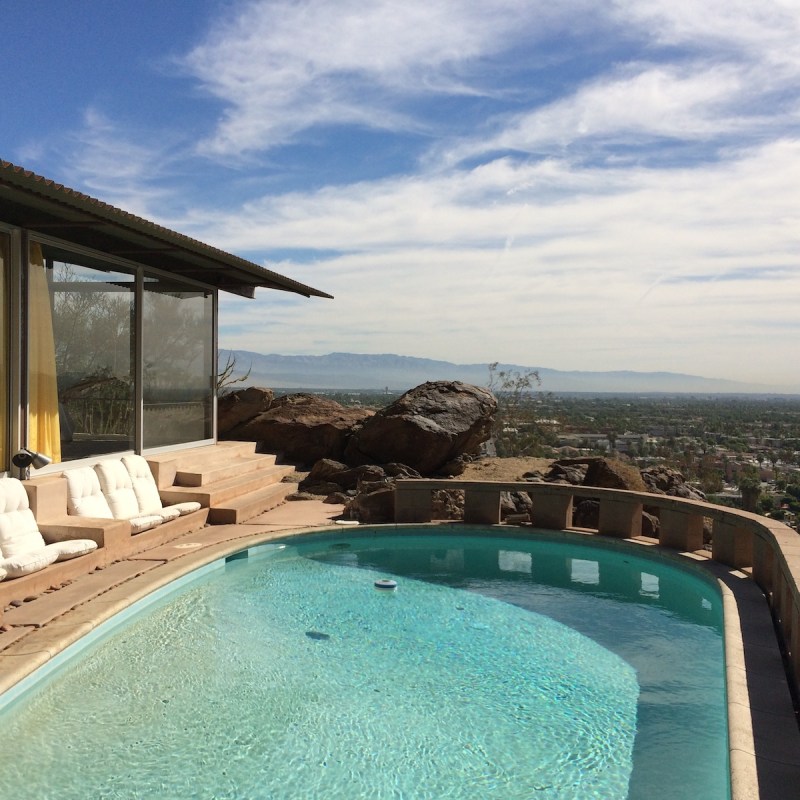
Palm Springs is a time capsule of Mid-century Modern architecture. The city has the most extensive collection in the world. If you are an architecture fan, it’s a thrilling experience to explore the neighborhoods and view the spectacular homes reflecting the modern design of the late 1930s to 1970s.
Videos by TravelAwaits
It was a time of post-war optimism and Hollywood glamour. Palm Springs was a playground for the rich and famous who escaped to the desert for the winter months. Hollywood stars were under strict rules from their studios to stay within 120 miles of their lots. Palm Springs was within the limit. Photographers were under the thumb of the studios and were not allowed to photograph any movie star without their consent. In Palm Springs, the stars could relax and let the good times roll.
The inspiring natural surroundings drew modernist architects because of the stunning mountains and the Coachella Valley desert. These creatives embraced the dramatic landscape in their sleek designs, a variation on Bauhaus or International Style but desert-inspired. One of the first architects was Albert Frey, referred to as the founding father of Desert Modernism. The famous Swiss architect worked in New York, but after a visit in 1934, he fell in love with the area. He returned in 1939 and never left.

According to architecture expert and founder of Palm Springs Mod Squad, Kurt Cyr, “Palm Springs was a resort community. Residents only lived here for a part of the year, and because of that, they were open to new ideas and modern designs for their second homes.”
Cyr explains four distinct elements of Mid-century Modern homes; the first is the cantilever roof, an unsupported roof section that extends out past the roofline. The second is the clerestory windows installed at the roofline to add light. The third is Brise soleil (French for sunscreen) that allows in light but reduces heat. The shadow block or raised pattern walls was the fourth element. It allowed for privacy, and decorative flair as changing shadows created designs from the sun’s rays.
The following examples are five architecturally significant homes. Two are designated as Class 1, “the highest, most prestigious historic designation available in Palm Springs.” These homes are excellent examples of the modernist movement. They should be on your list when visiting the Capital of Mid-century Modern architecture. Still, luckily due to historic preservation, there are many examples to see. Taking a tour to view them is a must when visiting Palm Springs.
I was a guest of Palm Springs Preferred Small Hotels for the PSModSquad Tour, but all opinions are my own.

1. Twin Palms – Sinatra House Architect E. Stewart Williams
Twin Palms on Alejo Road was Frank Sinatra’s primary residence from 1948 to 1957. He walked into the Williams design firm, licking an ice cream cone. He had just signed a movie contract with MGM Studios, and the newly minted millionaire wanted a Georgian-style mansion. Back home in Hoboken, New Jersey, a home-like that meant you made it. But, in the desert, that wouldn’t have worked at all. E. Stewart Williams drew plans for two homes, the Georgian and one of his designs. He explained to Mr. Sinatra why his Desert Modern concept would be the better choice. The long horizontal lines and sliding glass windows would allow for stunning views of the mountains, blurring the outside and the inside. The sprawling home allowed plenty of space for his wife Nancy and his three children (each had their own bedroom) and a private master suite for the couple. The courtyard included a long-covered walkway, a patio, and a piano-shaped pool. Two palm trees, a signature part of the landscaping, become the namesake for the home. The exterior neutral color blended into the surroundings. Frank was sold and employed the architect in May of 1947, requesting Twin Palms be ready by Christmas. He delivered. Frank threw legendary parties and signaled cocktail hour by hoisting a flag between the palms. He had a landing strip outside to hop into his private plane and return to the studio. His was the first “shed roof” house in Palm Springs and was designated a Class 1 Historic Site by the city in 2011. When he lived at home with Ava Gardner, his second wife, they fought so bitterly that Ava threw a champagne bottle at Frank. The bottle left a crack in a bathroom sink and was never repaired. The house is available to rent for parties or special events.

2. House of Tomorrow — Elvis Honeymoon Hideaway Architect William Krisel
The House of Tomorrow on Ladera Circle was Bob Alexander’s estate. The local real estate developer had it built for his own family in the Vista Las Palmas neighborhood. Based on four circles on three levels, the design looks like it’s launching from the enormous boulder. It was called the House of Tomorrow because of its futuristic shape, and it’s one of the most interesting Mid-century homes in Palm Springs. It has terrazzo floors, stone-clad walls, and four circular wings that total 5,000 square feet. Other features include a sunken living room with a ring of clerestory windows and a fireplace hanging from the ceiling in the center of the room with built-in couches. There are five bedrooms and bathrooms in the funky home. The backyard features a lot of lush landscaping with a chevron-shaped pool. The home sheltered Elvis and Priscilla Presley, who hid out here during their courtship and famous wedding in Las Vegas. The noted couple wanted to escape the public eye when they spent their honeymoon here. Still, they didn’t know that gossip columnist Rona Barrett resided in the home across the street. This home recently sold for 2.6 million dollars and is undergoing significant renovations.

3. Kaufmann House — Site of “Poolside Gossip” Architect Richard Neutra
The Kaufmann House became the home of Edgar Kaufmann, the owner of the Kaufmann Department store in Pittsburgh, Pennsylvania. Kaufmann loved modern homes and hired Frank Lloyd Wright to build Fallingwater in 1936. Ten years later, Kaufmann wanted to create a vacation home in Palm Springs in the style of a Desert Modern home. He chose architect Richard Neutra because he felt Wright didn’t understand desert design. After its completion in 1947, even Wright agreed that it was beautiful. Neutra used glass, steel, and stone to create a home with multiple wings branching off from the center of the house, much like a pinwheel. There is a second-story outdoor living room where subsequent owners have enjoyed cocktails alfresco. The building is internationally famous for its design and a photograph from the 1970s by photographer Slim Aarons. The iconic photo “Poolside Gossip” became a symbol of modernism. The image was of a group of casually dressed socialites sitting by a rectangular swimming pool. They were sipping drinks against the backdrop of the mountains and the gorgeous modern home designed by Neutra. It is considered one of the 10 most important residential designs in the world.

4. Edris House — Architect E. Stewart Williams
The Edris House on W Cielo Drive was built seven years after Twin Palms in 1954. William and Marjorie Edris were friends with the Williams and wanted Stewart to make them a winter home. They chose a rocky plot in the Tuscany Heights neighborhood and gave their friend free rein with no budget. The result was spectacular, and it’s still relevant. Williams only moved a few boulders and used the natural landscape in the design. Floor-to-ceiling windows in the living room allow that blur between the indoor and outdoor spaces allowing stunning views of the Coachella Valley and plenty of gorgeous light to flood the home. Natural materials like wood and rock create that same blur on the exterior of the house. Williams designed the home to look “As if it grew out of the ground rather than falling out of the sky.”

5. William Holden Estate — Architect John Porter Clark, Master Builder Joseph Pawling
The William Holden Estate (also known as the Barrett Residence) is a one-acre “through lot” in the desirable Deepwell neighborhood built in 1956. Through lot means the home has frontage on more than one street. Actor William Holden purchased the 4,559 square foot home in 1966 and lived there with actress Stephanie Powers until 1977. The main house has three bedrooms with ensuite bathrooms, and there are two guesthouses attached to the main building, making it a five-bedroom five-and-a-half-bathroom home. The entire compound has a flat, cantilevered roof. Forty-seven floor-to-ceiling glass walls pivot to the enormous backyard, which has a 55 by 21-foot pool along with incredible views of the San Jacinto Mountains. It was designated as a Class 1 Historic Site by Palm Springs in March of 2018.
Pro Tips: The best time to visit Palm Springs is from February to April when the temperatures are around the mid-70s. In February, be sure to experience Modernism Week, it’s an 11-day festival with architecture tours, garden tours, parties, special events, and informative talks. All the events are open to the public, and many are inexpensive or completely free. There are festivals and events throughout the year. Check here for a full listing.
Want to immerse yourself in Mid-century style? Check out our list of the best Airbnbs in Palm Springs, which features some classic Mid-century modern homes that you can rent for your desert getaway.
Learn more about Palm Springs with these articles:
